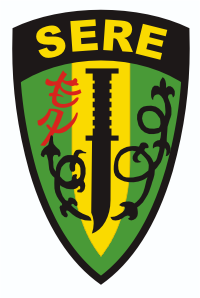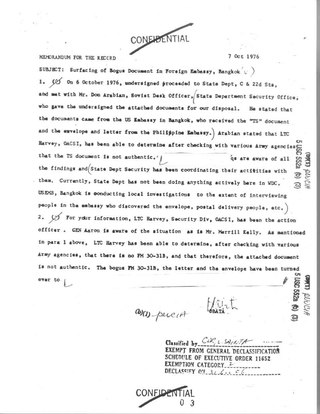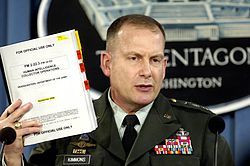The United States Armed Forces are the military forces of the United States. The armed forces consist of six service branches: the Army, Marine Corps, Navy, Air Force, Space Force, and Coast Guard. All six armed services are among the eight uniformed services of the United States.
Military doctrine is the expression of how military forces contribute to campaigns, major operations, battles, and engagements. A military doctrine outlines what military means should be used, how forces should be structured, where forces should be deployed, and the modes of cooperation between types of forces. "Joint doctrine" refers to the doctrines shared and aligned by multinational forces or joint service operations.

A fireteam or fire team is a small modern military subordinated element of infantry designed to optimize "NCO initiative", "combined arms", "bounding overwatch" and "fire and movement" tactical doctrine in combat. Depending on mission requirements, a typical "standard" fireteam consists of four or fewer members: an automatic rifleman, a grenadier, a rifleman, and a designated fireteam leader. The role of each fireteam leader is to ensure that the fireteam operates as a cohesive unit. Two or three fireteams are organized into a section or squad in co-ordinated operations, which is led by a squad leader.

The United States Army Special Forces (SF), colloquially known as the "Green Berets" due to their distinctive service headgear, is the special operations branch of the United States Army. Although technically an Army branch, the Special Forces operates similarly to a functional area (FA), in that individuals may not join its ranks until having served in another Army branch.

Survival, Evasion, Resistance, and Escape (SERE) is a training program, best known by its military acronym, that prepares U.S. military personnel, U.S. Department of Defense civilians, and private military contractors to survive and "return with honor" in survival scenarios. The curriculum includes survival skills, evading capture, application of the military code of conduct, and techniques for escape from captivity. Formally established by the U.S. Air Force at the end of World War II and the start of the Cold War, it was extended to the Navy and United States Marine Corps and consolidated within the Air Force during the Korean War (1950–1953) with greater focus on "resistance training".

The brigade combat team (BCT) is the basic deployable unit of maneuver in the U.S. Army. A brigade combat team consists of one combat arms branch maneuver brigade, and its assigned support and fire units. A brigade is normally commanded by a colonel (O-6) although in some cases a brigadier general (O-7) may assume command. A brigade combat team contains combat support and combat service support units necessary to sustain its operations. BCTs contain organic artillery training and support, received from the parent division artillery (DIVARTY). There are three types of brigade combat teams: infantry, Stryker, and armored.
The US Army Field Manual on Interrogation, sometimes known by the military nomenclature FM 34-52, is a 177-page manual describing to military interrogators how to conduct effective interrogations while conforming with US and international law. It has been replaced by FM 2-22.3 Human Intelligence Collector Operations.

The TM 31-210 Improvised Munitions Handbook is a 256 page United States Army technical manual intended for the United States Army Special Forces. It was first published in 1969 by the Department of the Army.

The U.S. Army John F. Kennedy Special Warfare Center and School (SWCS) – known informally as "Swick" – primarily trains and educates United States Army personnel for the United States Army Special Operations Command and United States Special Operations Command, which includes Special Forces, Civil Affairs, and Psychological Operations personnel. Its purpose is to recruit, assess, select, train and educate the U.S. Army Civil Affairs, Psychological Operations and Special Forces Soldiers by providing training and education, developing doctrine, integrating force-development capability, and providing career management.

Command and control is a "set of organizational and technical attributes and processes ... [that] employs human, physical, and information resources to solve problems and accomplish missions" to achieve the goals of an organization or enterprise, according to a 2015 definition by military scientists Marius Vassiliou, David S. Alberts, and Jonathan R. Agre. The term often refers to a military system.

The US Army Field Manual 30-31B, dubbed the "Westmoreland Field Manual," purportedly outlined a strategy called the "strategy of tension," wherein violent attacks are orchestrated and blamed on left-wing groups to justify government action. However, it was revealed to be a Cold War-era hoax conducted by Soviet intelligence services.
A logical line of operation (LLO) is an obsolete American military doctrinal concept. It was originally used along with the separate term line of operation which described a geographic line from a base of operations to a military objective. The qualifier "logical" indicated the pursuit of military objectives that did not necessarily require a physical or geographic description, such as governance capacity-building and development activities.
In US military doctrine, unconventional warfare is one of the core activities of irregular warfare. Unconventional warfare is essentially support provided by the military to a foreign insurgency or resistance. The legal definition of UW is:
Unconventional Warfare consists of activities conducted to enable a resistance movement or insurgency to coerce, disrupt or overthrow an occupying power or government by operating through or with an underground, auxiliary or guerrilla force in a denied area.

Maxie L. McFarland, was one of thirteen tier-3 US Government Defense Senior Executives, serving as the Deputy Chief of Staff for Intelligence (G–2) for the U.S. Army's Training and Doctrine Command located at Fort Monroe, Virginia. Starting in June 2011, he worked as the Executive Vice President for Strategic Planning for the Sierra Nevada Corporation. Maxie McFarland died on 8 November 2013 and is buried at Arlington National Cemetery. He was inducted into the Military Intelligence Hall of Fame in 2014.
For military strategy, intent is the desired outcome of a military operation. It is a key concept in 21st century military operations and is a vital element to facilitate subordinates' initiative and collaboration and cooperation amongst team members in joint operations.
Information Operations is a category of direct and indirect support operations for the United States Military. By definition in Joint Publication 3-13, "IO are described as the integrated employment of electronic warfare (EW), computer network operations (CNO), psychological operations (PSYOP), military deception (MILDEC), and operations security (OPSEC), in concert with specified supporting and related capabilities, to Information Operations (IO) are actions taken to affect adversary information and information systems while defending one's own information and information systems.
16-line message format, or Basic Message Format, is the standard military radiogram format for the manner in which a paper message form is transcribed through voice, Morse code, or TTY transmission formats. The overall structure of the message has three parts: HEADING, TEXT, and ENDING. This heading is further divided into procedure, preamble, address, and prefix. Each format line contains pre-defined content. An actual message may have fewer than 16 actual lines, or far more than 16, because some lines are skipped in some delivery methods, and a long message may have a TEXT portion that is longer than 16 lines by itself.

Security Force Assistance (SFA) a term originating in the United States Armed Forces for military adviser assistance with "training, equipping and advising allied or 'partner' militaries to enable them to defend themselves without 100,000 Americans on the ground to do it for them." SFA is used when improving the security of the host country aligns with the national interests of the donor country. It may be used alongside or instead of larger commitments of the donor country's military personnel and matériel. This means SFA can provide an alternative to large-scale operations if a war becomes controversial or politically difficult.
Field Manual 100-5 (FM100-5) is a serial publication of the US Army. In 1997, the 1986 edition was termed "the primary tool for the self-education and professional development required to achieve tactical competence." In 1939 it was said to contain the principles of troop leading and combat of the combined arms in maneuver warfare and constitutes the basis of instruction of all arms and services for field service.











